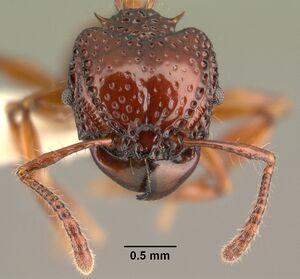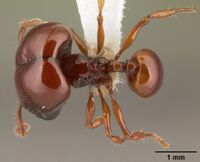Acanthomyrmex concavus
| Acanthomyrmex concavus | |
|---|---|

| |
| Scientific classification | |
| Kingdom: | Animalia |
| Phylum: | Arthropoda |
| Class: | Insecta |
| Order: | Hymenoptera |
| Family: | Formicidae |
| Subfamily: | Myrmicinae |
| Tribe: | Crematogastrini |
| Genus: | Acanthomyrmex |
| Species: | A. concavus |
| Binomial name | |
| Acanthomyrmex concavus Moffett, 1986 | |
Specimens have been found in leaf litter from a rainforest and a mature wet forest.
Identification
Moffett (1986) - Minors with head deeply concave dorsad and thus resembling Acanthomyrmex luciolae and Acanthomyrmex basispinosus, except: propodeal spines without a distinct thickened base, strongly directed caudad; mandibles each with a ventral tooth; medial clypeal lobes well-developed, projecting; postpetiole with only two pairs of hairs dorsally. Major worker unknown.
A Sabah specimen has a distinctive, bilobed petiolar node.
Keys including this Species
Distribution
Latitudinal Distribution Pattern
Latitudinal Range: 4.95° to 4.199°.
| North Temperate |
North Subtropical |
Tropical | South Subtropical |
South Temperate |
- Source: AntMaps
Distribution based on Regional Taxon Lists
Indo-Australian Region: Borneo (type locality), Indonesia, Malaysia.
Distribution based on AntMaps
Distribution based on AntWeb specimens
Check data from AntWeb
Countries Occupied
| Number of countries occupied by this species based on AntWiki Regional Taxon Lists. In general, fewer countries occupied indicates a narrower range, while more countries indicates a more widespread species. |

|
Estimated Abundance
| Relative abundance based on number of AntMaps records per species (this species within the purple bar). Fewer records (to the left) indicates a less abundant/encountered species while more records (to the right) indicates more abundant/encountered species. |

|
Biology
Life History Traits
- Queen type: ergatoid (Yamada et al. 2018) (ergatoid intermediate size between major and minor)
Castes
Worker
Minor
Images from AntWeb
     
| |
| Worker. Specimen code casent0101061. Photographer April Nobile, uploaded by California Academy of Sciences. | Owned by MHNG, Geneva, Switzerland. |
Major
Images from AntWeb

| |
| Worker. Specimen code casent0101062. Photographer April Nobile, uploaded by California Academy of Sciences. | Owned by MHNG, Geneva, Switzerland. |
Nomenclature
The following information is derived from Barry Bolton's Online Catalogue of the Ants of the World.
- concavus. Acanthomyrmex concavus Moffett, 1986c: 80, figs. 39B-C, 44-47 (w.) BORNEO (East Malaysia: Sarawak, Sabah).
- Type-material: holotype minor worker, 1 paratype minor worker.
- Type-locality: holotype Malaysia: Sarawak, 4th Division, Gunung Mulu Nat. Park, RGS Expd., Long Pala, 19.x.1977, lowland rainforest, leaf litter (B. Bolton); paratype with same data.
- Type-depositories: BMNH (holotype); MCZC (paratype).
- Status as species: Bolton, 1995b: 53; Pfeiffer, et al. 2011: 44; Yamada, Ito, et al. 2018: 10.
- Distribution: Malaysia (Sabah, Sarawak).
Description
Worker
Minor. Holotype and single paratype measure HW 1.10, HL 0.90 (CI 122), ML 0.78 to 0.79 (MI 87 to 88), SL 0.90 (SI 82), EL 0.16 to 0.17, HFL 1.00 to 1.03 (FLI 111 to 114; FWI 24) mm. Posterior margin of head deeply concave in dorsal full-face view; head shape similar to A. luciolae, but with lateral margins of head less strongly convex. Head widest above the eyes. Head with rounded foveae having thick walls; dorsally the longest hairs extend 0.10 to 0.12 mm. Scapes short (SI < 90). Clypeal index 140 to 144. Lobe to each side of medial clypeal hair strongly produced, but widely separated from the hair; lateral clypeal hairs in a completely enclosed fovea. Smooth medial area of clypeus not bordered laterally by rugae. Mandibles with a small but distinct ventral tooth.
Spines on trunk virtually straight, with propodeal spines extending more directly caudad than in other species; pronotal spines short, stubby, and lacking conspicuous hairs. Pronotal angle forming a feeble tooth. Sculpture on trunk particularly deeply impressed. Propodeal declivity transversely rugose, and bordered on each side by two adjacent rugae.
Petiolar node rounded, without dorsolateral teeth, so that PWI not measurable. Anterior peduncle of petiole long and narrow, and lacking lateral and sublateral hairs; subpetiolar declivity present. Postpetiole subrectangular, about one third wider than it is long, rounded dorsad and only feebly rugose on sides; with two pairs of hairs dorsally. Femora hairy, and with ventral surfaces distinctly concave; hind femora relatively short (FLI < 120). Color dark orange red, with legs and gaster lighter and more orange.
Type Material
Holotype. Minor worker deposited in The Natural History Museum from Malaysia; Sarawak; 4th Div., Gunung Mulu National Park, RGS Exped., Long Pala, lowland rainforest leaf litter, 19/X/1977 (B. Bolton).
Paratypes. One minor worker, same collection data as holotype (Museum of Comparative Zoology).
Etymology
Name refers to strongly concave posterior margin of head.
References
- Moffett, M.W. 1986c. Revision of the myrmicine genus Acanthomyrmex. Bulletin of the Museum of Comparative Zoology. 151:55-89. [15.viii.1986.]
- Yamada, A., Ito, F., Hashim, R. and K. Eguchi. 2018. Queen polymorphism in Acanthomyrmex careoscrobis Moffett, 1986 in Peninsular Malaysia (Hymenoptera: Formicidae: Myrmicinae), with descriptions of hitherto unknown female castes and males. Asian Myrmecology. 10:e010009:1-14. doi:10.20362/am.010009
References based on Global Ant Biodiversity Informatics
- Moffett, M. W. 1986. Revision of the myrmicine genus Acanthomyrmex (Hymenoptera: Formicidae). Bulletin of the Museum of Comparative Zoology 151:55-89.
- Pfeiffer M., D. Mezger, and J. Dyckmans. 2013. Trophic ecology of tropical leaf litter ants (Hymenoptera: Formicidae) - a stable isotope study in four types of Bornean rain forest. Myrmecological News 19: 31-41.
- Pfeiffer M.; Mezger, D.; Hosoishi, S.; Bakhtiar, E. Y.; Kohout, R. J. 2011. The Formicidae of Borneo (Insecta: Hymenoptera): a preliminary species list. Asian Myrmecology 4:9-58
- Yamane S., T. Itino, and A.R. Nona. 1996. Ground ant fauna in a Bornean dipterocarp forest. Raffles Bulletin of Zoology 44(1): 253-262.
- Yamane S.; Nona, A. R. 1994. Ants from Lambir Hills National Park, Sarawak. Pp. 222-226 in: Inoue, T.; Hamid, A. A. (eds.) 1994. Plant reproductive systems and animal seasonal dynamics. Long-term study of dipterocarp forests in Sarawak. Kyoto: Center for Ecological Research, Kyoto University, vii + 255 pp.
- Yamane Sk., T. Itino, and A. Rahman Nona. 1996. Ground ant fauna in a Bornean dipterocarp forest. The Raffles Bulletin of Zoology 44(1): 253-262.

